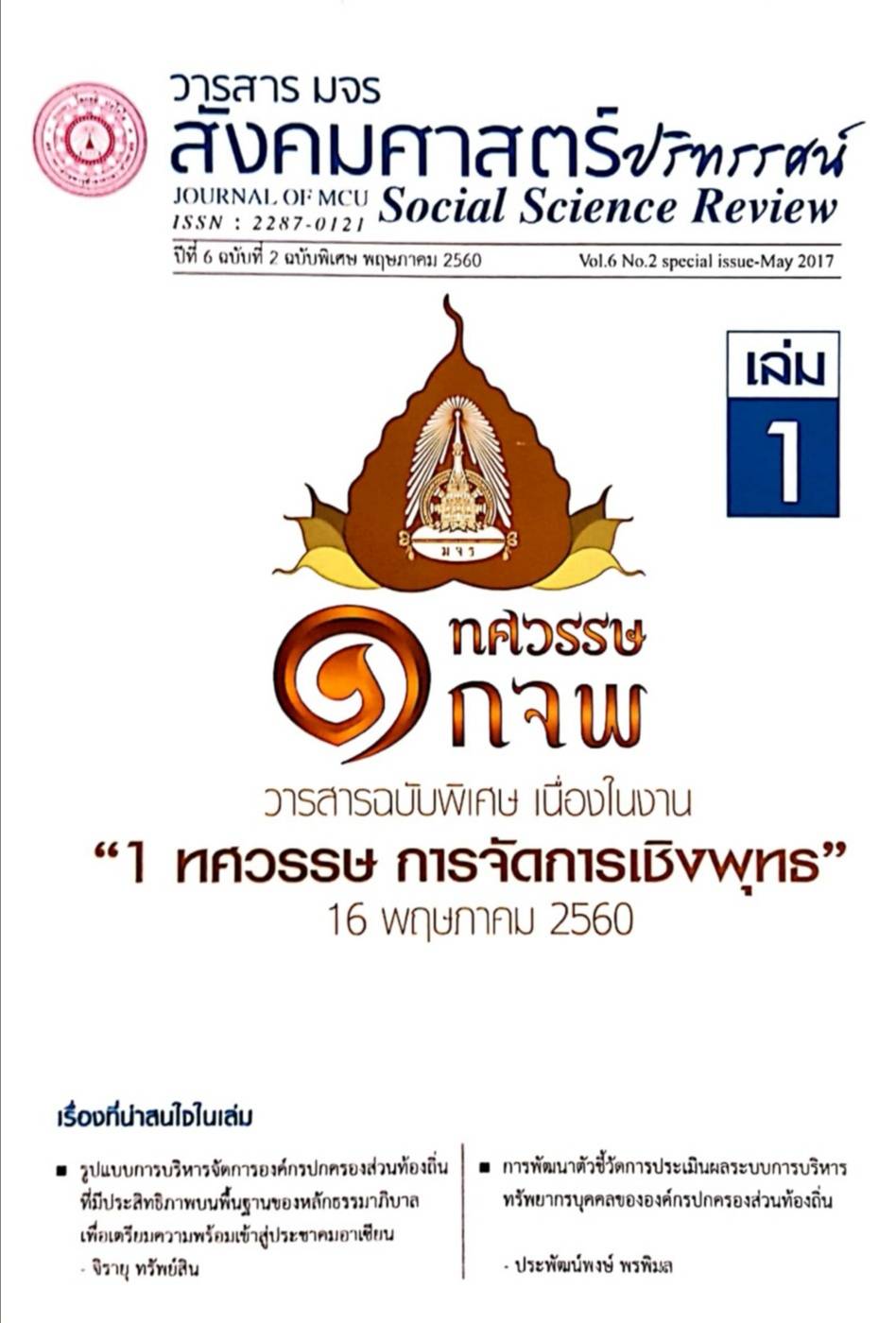รูปแบบการจัดการการเผยแผ่พระพุทธศาสนาที่ส่งเสริมการดำเนินชีวิตและธำรง เอกลักษณ์ของชาวมอญในกรุงเทพมหานครและปริมณฑล
คำสำคัญ:
รูปแบบการจัดการการเผยแผ่พระพุทธศาสนา, การดาเนินชีวิตและธารงเอกลักษณ์ของ ชาวมอญบทคัดย่อ
การวิจัยนี้มีวัตถุประสงค์เพื่อ 1) ศึกษาสภาพปัญหาทั่วไปและรูปแบบการจัดการการเผย
แผ่พระพุทธศาสนาที่ส่งเสริมการดาเนินชีวิตและธารงเอกลักษณ์ของชาวมอญในกรุงเทพมหานคร
และปริมณฑล 2) ศึกษาวิธีการจัดการการเผยแผ่พระพุทธศาสนาที่เสริมสร้างวิถีการดาเนินชีวิตใน
การธารงเอกลักษณ์ของชาวมอญ รวมทั้งสภาพปัญหาและอุปสรรคในการเผยแผ่พระพุทธศาสนา 3)
พัฒนารูปแบบการจัดการการเผยแผ่พระพุทธศาสนาที่ส่งเสริมการดาเนินชีวิตและธารงเอกลักษณ์
ของชาวมอญในกรุงเทพมหานคร และปริมณฑล
ระเบียบวิธีวิจัยเป็นแบบผสานวิธี ระหว่างการวิจัยเชิงคุณภาพ และการวิจัยเชิงปริมาณ
การวิจัยเชิงปริมาณ ใช้เก็บข้อมูลด้วยแบบสอบถามจากลุ่มตัวอย่างจานวน 374 รูป วิเคราะห์ข้อมูล
ด้วยสถิติพรรณนา ด้วยค่าร้อยละ ค่าเฉลี่ย ส่วนเบี่ยงเบนมาตรฐาน และการวิจัยเชิงคุณภาพ เก็บ
ข้อมูลจากผู้ให้ข้อมูลหลัก จานวน 18 รูป/คน ด้วยแบบสัมภาษณ์เชิงลึกที่มีโครงสร้าง ใช้การศึกษา
เอกสาร ประวัติศาสตร์ บทความ ผู้วิจัย และดาเนินการสนทนากลุ่มเฉพาะกับผู้ให้ข้อมูลสาคัญ
จานวน 13 รูป/คน วิเคราะห์ข้อมูลเชิงคุณภาพโดยใช้เทคนิคการวิเคราะห์เนื้อหาเชิงพรรณนา
ประกอบบริบท
ผลการวิจัย พบว่า
1) สภาพปัญหาทั่วไปและรูปแบบการจัดการการเผยแผ่พระพุทธศาสนาของชาวมอญ
เปิดโอกาสให้บุคคลภายนอกเข้ามาร่วมกิจกรรมเป็นการเผยแพร่เพื่อสาธารณะชน ให้คนทั่วไปได้
เรียนรู้และเห็นคุณค่าทางวัฒนธรรมวิถีชีวิตของคนมอญได้รวดเร็วและมากขึ้น และชาวมอญได้น้อม
นาเอาหลักธรรมในพระพุทธศาสนาไปปฏิบัติในชีวิตประจาวัน ส่วนใหญ่ชาวมอญปฏิบัติตาม
ประเพณีและพิธีกรรมประจาชีวิตเกี่ยวกับการเกิด การบวช การแต่งงาน และการตายสืบทอดกันมา
จากบรรพบุรุษ ในด้านความสัมพันธ์กับวิถีชีวิตของชาวมอญ ได้รับอิทธิพลจากพุทธศาสนา ชาวมอญ
จึงมีความขยันซื่อสัตย์สามัคคี และเอื้อเฟื้อเผื่อแผ่แก่เพื่อนบ้าน รักษาระเบียบประเพณีของสังคมชาวมอญปฏิบัติตามสิ่งเหล่านี้เสมอจึงได้อยู่ในครอบครัวและชุมชนอย่างสงบสุข มีการใช้ภาษามอญ
ในการสื่อสารในชุมชนมอญแต่ละชุมชนในจังหวัดต่างๆ
2) วิธีการเผยแผ่พระพุทธศาสนาในรูปแบบของประเพณีวัฒนธรรม คติ ความเชื่อ
พิธีกรรม และค่านิยมของชาวมอญ ชาวมอญมีอัตลักษณ์ที่โดดเด่น ไม่ว่าจะเป็นสถาปัตยกรรม
พิธีกรรม การแต่งกายและภาษา และปัจจุบันชาวมอญพยายามฟื้นฟูภาษาของตน สร้างแบบเรียน
และนิทานท้องถิ่นสาหรับเยาวชน รูปแบบการจัดการการเผยแผ่พระพุทธศาสนาที่ส่งเสริมการ
ดาเนินชีวิตและธารงเอกลักษณ์ของชาวมอญในกรุงเทพมหานครและปริมณฑล โดยภาพรวม อยู่ใน
ระดับมาก ( ̅=3.59, S.D.=0.734) และเมื่อพิจารณารายด้าน พบว่า รูปแบบการจัดการการเผยแผ่
พระพุทธศาสนาที่ส่งเสริมการดาเนินชีวิตและธารงเอกลักษณ์ของชาวมอญในกรุงเทพมหานครและ
ปริมณฑล ด้านเทศนาธรรม มีค่าเฉลี่ยสูงสุด ( ̅=3.47, S.D.=0.970) อยู่ในระดับมาก รองลงมา
ด้านอภิปรายธรรม ( ̅=3.64, S.D.=0.735) อยู่ในระดับมาก และด้านการใช้สื่อและอุปกรณ์
ประกอบการสอนธรรมะ มีค่าเฉลี่ยต่าสุด ( ̅=3.81, S.D.=0.725) อยู่ในระดับปานกลาง ทั้งนี้อาจ
เป็นเพราะผู้เผยแผ่ขาดการสนับสนุนด้านงบประมาณจากหน่วยงานอื่น ทาให้ไม่สามารถบริหาร
จัดการด้านการเผยแผ่ได้อย่างมีประสิทธิภาพ
3) รูปแบบการจัดการการเผยแผ่พระพุทธศาสนาที่ส่งเสริมการดาเนินชีวิตและธารง
เอกลักษณ์ของชาวมอญ โดยผสมผสานการอนุรักษ์วัฒนธรรมประเพณีผ่านบทบาทพระสงฆ์ 4 ด้าน
ได้แก่ (1) ด้านการเทศนาธรรม มีการฟื้นฟูการอาราธนาภาษามอญ เทศนาธรรม การทาวัตรสวด
มนต์ การให้ศีลให้พรเป็นภาษามอญ (2) ด้านปาฐกถาธรรม การแสดงธรรมมุ่งเน้นให้เกิดประโยชน์
ในท้องถิ่น ต้องใช้ความรู้ ความสามารถที่จะเข้าถึงชุมชนชาวมอญ ซึ่งชาวมอญถือเป็นผู้เลื่อมใสใน
พระพุทธศาสนาอย่างเคร่งครัด (3) ด้านอภิปรายธรรม นามาเชื่อมโยงกับสถานการณ์ปัจจุบันมา
ประกอบการสอน (4) ด้านสนทนาธรรม ใช้ภาษาสุภาพ เข้าใจง่าย (5) ด้านการสอนสมถกรรมฐาน
มีการตอบข้อสงสัยหลังปฏิบัติ และสามารถนาหลักธรรมความรู้ที่ได้จากการอบรมปฏิบัติธรรม
นาไปใช้ในชีวิตประจาวัน (6) ด้านการใช้สื่อและอุปกรณ์ประกอบการสอนธรรมะ ใช้สื่อผ่าน
ประเพณี วัฒนธรรม ความเชื่อของชาวมอญ
เอกสารอ้างอิง
กาสักเต๊ะขันหมาก. (2553). หลักการวิจัยทางสังคมศาสตร์ : PrincipleofSocial
ScienceResearch. กรุงเทพฯ : สุรีวิยาสาส์น.
กุศลโพธิ์สุวรรณ. ( 2557). “ภาวะผู้นาการเผยแผ่พระพุทธศาสนาของพระมงคลเทพมุนี
(สด จนฺทสโร)”. วิทยานิพนธ์พุทธศาสตรดุษฎีบัณฑิต. สาขาวิชารัฐประศาสนศาสตร์.
บัณฑิตวิทยาลัย:มหาวิทยาลัยมหาจุฬาลงกรณราชวิทยาลัย.
ทัศนีย์เจนวิถีสุข. (2555). “การสื่อสารเชิงพุทธกับการเปลี่ยนแปลงสังคม”. วิทยานิพนธ์พุทธ
ศาสตรดุษฎีบัณฑิต. บัณฑิตวิทยาลัย:มหาวิทยาลัยมหาจุฬาลงกรณราชวิทยาลัย.
ประยูรอาษานาม. (2541) .คู่มือวิจัยทางการศึกษา. พิมพ์ครั้งที่2. คณะศึกษาศาสตร์
มหาวิทยาลัยขอนแก่น : มหาวิทยาลัยขอนแก่น.
พระครูภาวนาโสภิต (บุญรัตน์ เมืองวงศ์). (2553). “การบริหารการเผยแผ่พระพุทธศาสนาใน
ล้านนา”. วิทยานิพนธ์ปรัชญาดุษฎีบัณฑิต. สาขาวิชาการบริหารการพัฒนาทรัพยากร
มนุษย์. บัณฑิตวิทยาลัย:มหาวิทยาลัยมหาจุฬาลงกรณราชวิทยาลัย.
สมจิตรแก้วนาค. (2541). การพัฒนาและศึกษาความเป็นไปได้ของระบบการประกันคุณภาพ
หลักสูตรฝึกอบรมของกองทัพอากาศ. หลักสูตรปรัชญาดุษฎีบัณฑิตวิชาการวิจัยและพัฒนา.
บัณฑิตวิทยาลัย : มหาวิทยาลัยศรีนครินทรวิโรฒประสานมิตร.
ดาวน์โหลด
เผยแพร่แล้ว
รูปแบบการอ้างอิง
ฉบับ
ประเภทบทความ
สัญญาอนุญาต
ลิขสิทธิ์ (c) 2020 วารสาร มจร สังคมศาสตร์ปริทรรศน์

อนุญาตภายใต้เงื่อนไข Creative Commons Attribution-NonCommercial-NoDerivatives 4.0 International License.
เพื่อให้เป็นไปตามกฎหมายลิขสิทธิ์ ผู้นิพนธ์ทุกท่านต้องลงลายมือชื่อในแบบฟอร์มใบมอบลิขสิทธิ์บทความให้แก่วารสารฯ พร้อมกับบทความต้นฉบับที่ได้แก้ไขครั้งสุดท้าย นอกจากนี้ ผู้นิพนธ์ทุกท่านต้องยืนยันว่าบทความต้นฉบับที่ส่งมาตีพิมพ์นั้น ได้ส่งมาตีพิมพ์เฉพาะในวารสาร มจร สังคมศาสตร์ปริทรรศน์ เพียงแห่งเดียวเท่านั้น หากมีการใช้ภาพหรือตารางหรือเนื้อหาอื่นๆ ของผู้นิพนธ์อื่นที่ปรากฏในสิ่งตีพิมพ์อื่นมาแล้ว ผู้นิพนธ์ต้องขออนุญาตเจ้าของลิขสิทธิ์ก่อน พร้อมทั้งแสดงหนังสือที่ได้รับการยินยอมต่อบรรณาธิการ ก่อนที่บทความจะได้รับการตีพิมพ์ หากไม่เป็นไปตามข้อกำหนดเบื้องต้น ทางวารสารจะถอดบทความของท่านออกโดยไม่มีข้อยกเว้นใดๆ ทั้งสิ้น





